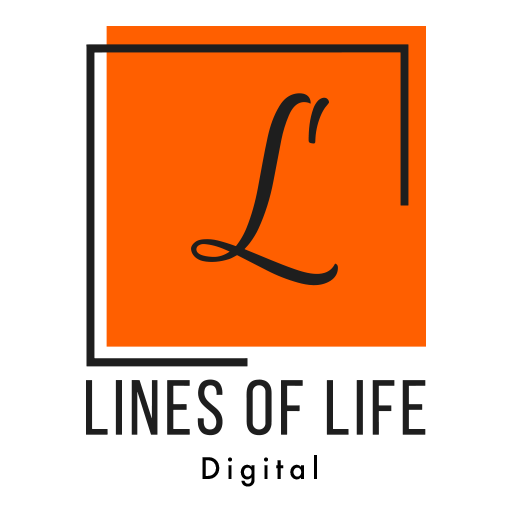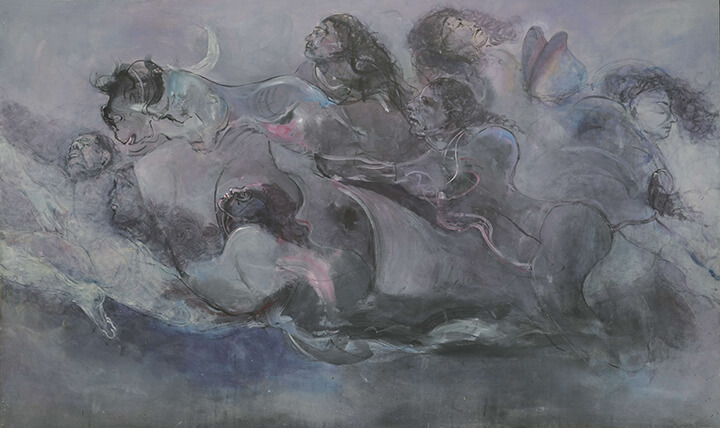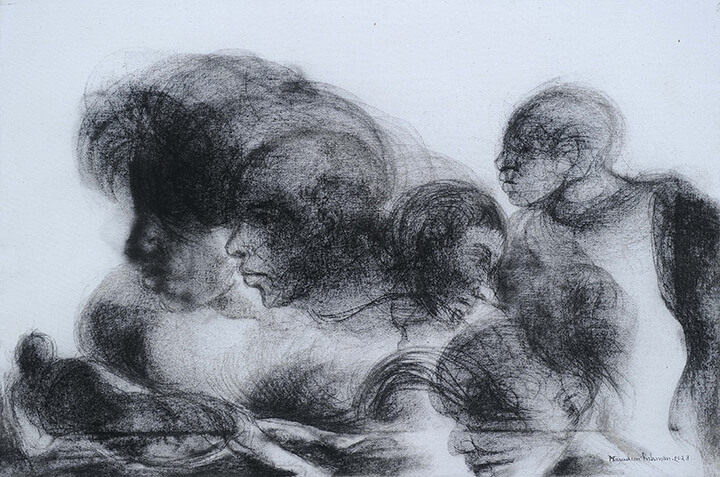
2ND SOLO EXHIBITION BY MASUDUR RAHAMAN, JOURNEY OF THE COSMOS, 6 SEP TO 14 SEP, 2024, Alliance Française de Dhaka
MASUDUR RAHAMAN 2ND SOLO SHOW

মহাকাল এবং মহাশূন্যতার যে বোধ মানুষের মনে সদা জাগ্রত, সে বোধই তার সৃষ্টি, প্রেম ও জীবনে এক অতল গভীরতা দান করে । মূলত এই অনন্ত শূন্যতাই আমাদের মৌলিক রূপ । আমি সেই শূন্যতার ভিতর থেকে একবার আকারে আর একবার নিরাকারে রচিত হই বারবার । এই আকার আর নিরাকারের যুগল রূপই “জীবন” ঠিক এভাবেই আমার শিল্প রচনা মূর্ততা ও বিমূর্ততায় ব্যাপ্ত অভিব্যক্তি । এমনকি এই পার্থিব প্রাণ-প্রকৃতি এবং এই মহাশূন্য স্বরূপে উদ্ভাসিত । তখন এক বিশাল আমির সঙ্গে একীভূত হয়ে যায় অথবা অনন্ত কালের এক আমি কে টের পাই নিজের ভেতরে এবং বাইরে । তাইতো নদী, মাঠ, দূরের দিগন্ত রেখা, সবুজ বন, ফসলের মাঠ আকাশছোঁয়া কোন মহীরূহ নিজেরই স্বরূপে ধরা দেয়। প্রকৃতি চিত্রে সবুজ বন ফসলের মাঠ ছাপিয়ে বনতলের মানুষের অস্তিত্ব জেগে ওঠে । এভাবেই এই প্রকৃতি নিজেরই প্রতিকৃতি হয়ে ওঠে মর্ত্য ও মহাশূন্য ব্যাপী ।
The sense of vastness and emptiness that is always awake in the mind of man gives an immense depth to his creation, love and life. Basically in this infinite void is our basic form. I am created from within that void, once in form and once in formlesness. This dual form of shape and formlessness is life and this is how my artwork is an expression of embodiment and abstraction. Even manifesting this earthly life-nature and this cosmic self. Then one merges with the great Self or the Eternal Self that I perceive within and without. So the river, field, distant horizon line, green forest, crop field touching the sky any mahiruh (Big Tree) perceives as itself. In the picture of nature, the existence of people on the forest floor is overshadowed by green forest crop fields. This is how this nature becomes its own nature. Across mortals and space.
“The Blissful Lightness of Being”
The word ‘human’ represents an image, which is a nearly primordial concept of a ‘being’. This image requires unpacking, as after years of theological/philosophical interventions, a set of values is also attached to it. The image, thus, is lost without the words that are used as a framework around it. These discursive practices sometimes veer towards an essentialist position, while at others it remains closer to historical analyses of various kinds. However, there still exists an area of interest where the body and its essence is found inseparable as in the case of Lalon Fakir who places the human squarely within the geography of ‘bartaman’ (the present). Lalon, the most celebrated exponent of the bardic tradition of the past millennium in the Indian subcontinent, shows the way towards a hermeneutic excavation that may lead to the discovery of the ‘khod’ (actual) self. If this khod being is considered our starting point in the process of unmaking the modern man, the end result is nothing short of a decolonised and de-aestheticised human essence. It is through an almost similar deconstructive method that the painter Masudur Rahman is able to navigate around the conventional figurative practices to create a realm of humans where the cosmic dimension is key to their existence and unity. In all cosmopolitan environments, when we discuss the nature of human being, we acknowledge the vast grey area between the image and the narrative that binds that image. Humans as earthllings remain weighed down by earthly desires, thereby delimiting their operation –in actions and thoughts. The horizon where the human meets his/her ‘param’ is an imagined geography and it is a turf that Lalon creates within the body. He frames the being, or should one say the devotional being, the creature of divine address, as an authentic being whose occupation is to create an ‘asan’ or ‘seat’ for the guru or master, the omnipotent being. This way the separation between the human and the ‘param’ (the Supreme Being) is dissolved. When Masud pays attention to such a unity, he makes his humans float in the air, which a way for him to depict the state of being in the presence of a force that manifest itself only through His/Her creation. 2. Human forms have their own way of transmitting the collective state of existence. Seen in a cluster, they also become a bit abstract. As crowds or masses they need to be looked at through this veil of abstraction before one is able to determine what they ‘become’ in their moment of togetherness. If it is a particular set of worldly concerns which have inspired such a congregation, it is the vox populi, the voice of the majority people, through which a crowd is recognised as a democratic political mass. But as a crowd, or a cluster of bodies caught up in a cosmic rhythm, what do the human actors articulate? And, most of all, what type of ‘unity’ binds these human actors together? These are the questions that surge to the fore while contemplating the images Masudur Rahman has brought into existence. The artist who is having his 2nd solo exhibition toys with the idea of existence from the point of view of a spiritualist, if not a theist. In layman’s terms, Masudur or Masud deals with ‘floating figures’ craving for things that lie beyond their reach. The gesturing and gesticulating men and women may thus be seen as individuals seeking to recreate the unity they once enjoyed in the ‘womb world’. Some psychologists suggests that the foetal stage conditions every person to desire some semblance of the bond of unity once felt in the cosmos of the womb. But, how does that ‘felt world’ extend from that immersive experience of floating in the amniotic fluid to the experience of the blissful lightness of the body? Setting aside the question whether this is the only way to mentally situate oneself close to the ‘whole’, one can asserts that this ‘state’ is not the result of barbiturate-induced biochemical changes. There are, of course, spiritual investments that come from within and without, or from the mind and the body. The artist feels that the individual body mirrors the entire universe and through its cosmic constitution one is able to come to understanding of the macro-level reality in this microcosmic reality. For him the self becomes a site of universal knowledge as he believes that the universe can be discovered through self-excavation, which is, without a doubt, a continuous process. Making the self a celestial agent has its dividends. The artist boldly sets aside the entire intellectual trajectory that we as moderns have accepted in the form of Western Existentialism. This is the threshold from where the artist’s works begin to unravel a narrative, affording a holistic understanding of life – a life in which the individual and the collective as well as the entire universe come to an alignment to form a whole. Such a unity is emancipatory as it not only elevates one from worldly concerns and allow one to feel the ‘lightness’ of being in the world, but also intensifies one’s existence through his or her emplacement within the elusive, but not illusory, ‘grand design’. No doubt, this is the realm we lost sight of due to the rise of Positivism, a Western mode of thinking through which the body remains forever separated from the mind, the individual from the collective and the human from the cosmos. Masudur recognises human beings in a ‘flow’, a rhythm through which they have always remained above the dross of the day-to-today affairs, which is in itself a rebellion against the norm. However, his attention is not set on the hierarchy of the lived experiences nor is it about the separation of the worldly and divine life. In fact, he unveils a geography where all human beings lose their sense of hierarchy. His non-judgemental, non-hierarchical gaze helps him discover that other than the social processes which lead us to a hierarchical society there is another form of ‘existence’ which connects us to a greater force and helps us imagine our bodies in relation to the grand design. For this artist life’s mystery lies in the lived experiences. Governed by a primordial force, life’s pleasures, agonies or even feelings of despair and abjection it gives rise to are like passing storms. Masudur Rahman may not have remained unaffected by the daily drudgery, but he finds a place of belonging even amidst the everyday chaos. By situating himself in a sensorium from which he aspires to travel ‘beyond’ the given time and space, he creates his imageries. As he keeps channeling his energies through the rhythmic forms and simultaneously lends form to the formless energy that he discovers in and outside the body, his imageries come to life and give us a sense of eternity. –
-MUSTAFA ZAMAN-
Artist, critic and curator based in Dhaka


























































